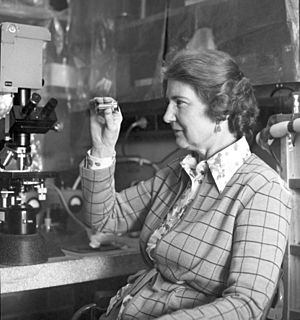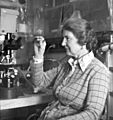Rachel Makinson facts for kids
Quick facts for kids
Rachel Makinson
AM FTSE
|
|
|---|---|

Makinson at work at CSIRO
|
|
| Born |
Kathleen Rachel White
15 February 1917 England
|
| Died | 18 October 2014 (aged 97) Sydney, New South Wales, Australia
|
| Alma mater | Newnham College, Cambridge, UK |
| Spouse(s) | Richard Elliss Bodenham Makinson (1913–1979) |
| Scientific career | |
| Fields | Physics |
| Institutions | Commonwealth Scientific and Industrial Research Organisation |
Kathleen Rachel Makinson (born Kathleen Rachel White) was an amazing Australian scientist. She was a physicist, which means she studied how the world works, from tiny atoms to huge forces. Rachel Makinson was the first woman to become a chief research scientist at Australia's main science organization, called CSIRO. She was born on February 15, 1917, and passed away on October 18, 2014.
Contents
Who Was Rachel Makinson?
Kathleen Rachel White was born in England on February 15, 1917. She was the oldest of three children. Even when she was young, her teachers remembered her as someone who loved to read a lot.
Rachel became very interested in science when she was about 12 or 13 years old. She said she "got hooked on atoms and molecules." Growing up in England during the Great Depression, her father lost his job. She also learned that women teachers were paid much less than men.
She went to Newnham College, Cambridge, which is part of the University of Cambridge in England. She earned a Bachelor of Arts degree in 1939. Later, in 1970, she completed her PhD in physics.
Rachel won a scholarship to study physics at Cambridge. She was planning to work with X-rays, but then she met an Australian physicist. She decided to move to Australia, marry him, and put her PhD on hold. She arrived in Australia with her husband, Richard Makinson, during World War II.
In Australia, her husband got a job teaching physics at the University of Sydney. But Rachel was not offered a similar job. At that time, it was very hard for married women to get jobs in Australia.
Becoming a Scientist
In the 1940s, Rachel Makinson, as she preferred to be called, found other ways to use her skills. She taught many RAAF airmen about radio physics. This helped them prepare for radar training. She then joined a team of 60 physicists at Australia's Commonwealth Scientific and Industrial Research Organisation (CSIRO). They were working to develop radar technology. Rachel was one of only three women on this important team.
Her Amazing Work with Wool
After World War II ended, scientists started to study wool fibers more closely. This was very important for Australian wool producers. Because of this, CSIRO created a new group called the Division of Textile Physics. Rachel Makinson was hired as a scientific officer. She became a world expert on how wool shrinks and gets matted. She also studied how to stop wool from shrinking.
Rachel said that at the time, "next to nothing" was known about wool. People didn't understand how wool fibers worked or why they shrank. The only way to stop wool from shrinking was using a chemical called chlorination. But this method often damaged the wool.
Rachel started working in the Division of Textile Physics in 1953. She became a senior principal research scientist in 1971. She spent her time carefully studying how wool fibers work. She looked at them very closely under a microscope. Even with her amazing skills, Rachel faced challenges. Because she was married, CSIRO would not give her a permanent job. For many years, she was a temporary employee and had to reapply for her job every year.
In the early 1960s, Rachel used her own success to help other women. She helped create the CSIRO Officers Association. Through this group, she worked to get equal pay for women staff members. She used her research skills to collect facts and figures. She showed the leaders how women were being treated unfairly in pay and job levels.
In 1977, Rachel Makinson became the first woman to be a chief research scientist at CSIRO. From 1979 to 1982, she was also the assistant chief of her division. She was the first woman to hold that position too.
Life After Science
Rachel loved being outdoors her whole life. She enjoyed walking in the bush and finding native plants. She also liked learning about Aboriginal Australia.
After her husband passed away in 1976, Rachel retired from CSIRO. She moved to the Blue Mountains. There, she became very active in protecting nature. She worked with the Blue Mountains Conservation Society. When her health got worse in the 1990s, she moved back to Sydney. She passed away on October 18, 2014. She is remembered by her two sons.
Awards and Recognition
- 1981: She was chosen as a Fellow of the Australian Academy of Technological Sciences and Engineering.
- 1982: She was made a Member of the Order of Australia (AM). This was for her important work in wool research.
- 1987: She became a Fellow of the Australian Academy of Technological Sciences and Engineering (FTSE).
- 2003: She received the Commonwealth Government's Centenary Medal. This was for her service to Australian society in textile physics.
Selected Publications
- Mercer, E. H., and K. Rachel Makinson. "20—the Frictional Properties of Wool and Other Textile Fibres." Journal of the Textile Institute Transactions 38.5 (1947): T227-T240.
- Makinson, K. Rachel. "On the cause of the frictional difference of the wool fibre." Transactions of the Faraday Society 44 (1948): 279–282.
- Makinson, K. Rachel. "Some Replica Techniques Useful in Electron Microscopy of the Surface of the Wool Fiber." Textile Research Journal 20.1 (1950): 22–28.
- Makinson, K. Rachel. "Studies of the Movement of Wool Fibers in Fabrics During Felting, With Particular Reference to the Permanency of Pleats: Part I: Light Felting and its Effect on Pleats in a Worsted Fabric." Textile Research Journal 29.5 (1959): 431–439.
- Makinson, K. Rachel, and David Tabor. "The friction and transfer of polytetrafluoroethylene." Proceedings of the Royal Society of London. Series A. Mathematical and Physical Sciences 281.1384 (1964): 49–61.
- Makinson, K. Rachel. "Some New Observations on the Effects of Mild Shrinkproofing Treatments on Wool Fibers." Textile Research Journal 38.8 (1968): 831–842.
- Makinson, K. Rachel. "Mechanisms involved in shrinkproofing by degradative treatments." (1971).
- Makinson, K. Rachel, and Judith A. Lead. "The nature and function of the resin in the chlorine/resin shrinkproofing treatment of wool tops." Textile Research Journal 43.11 (1973): 669–681.
- Makinson, K. Rachel. "The role of chlorine in oxidative antifelting treatments of wool." Textile Research Journal 44.11 (1974): 856–857.
Images for kids
See also
 In Spanish: Rachel Makinson para niños
In Spanish: Rachel Makinson para niños


